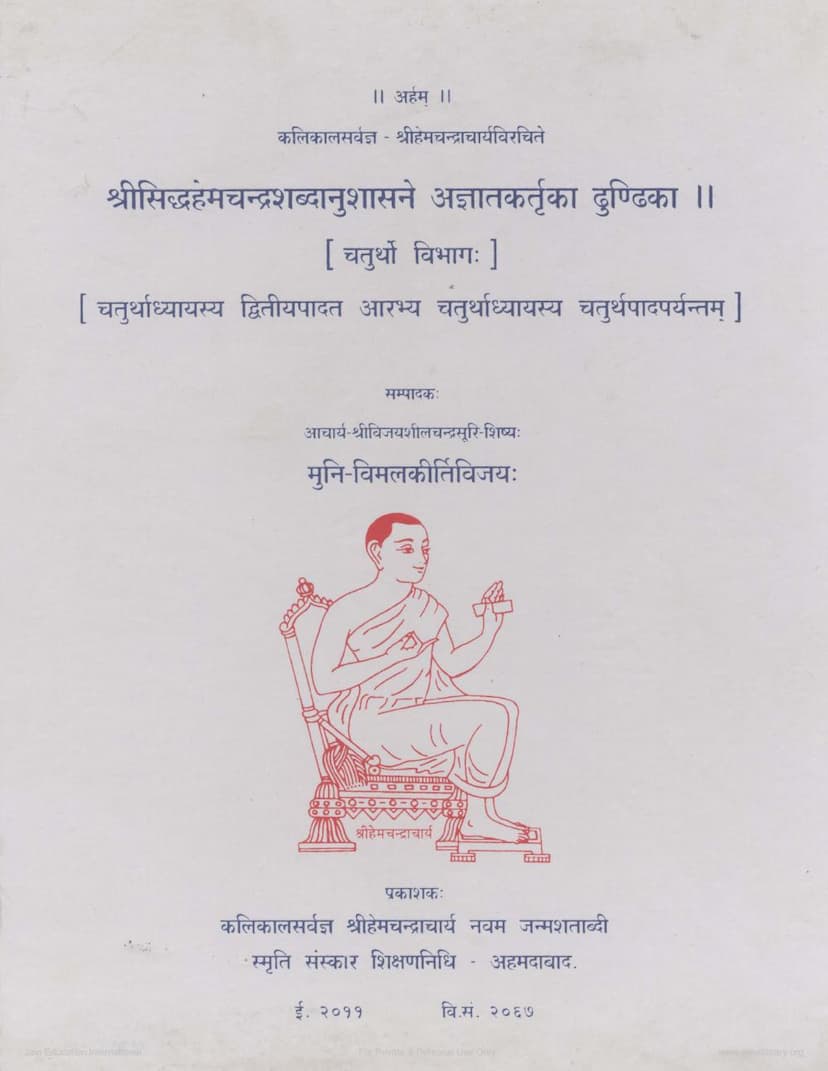Siddha Hemchandra Shabdanushasane Agyat Kartuka Dhundika Part 04
Added to library: September 2, 2025

Summary
This is a comprehensive summary of the Jain text "Siddha Hemchandra Shabdanushasane Agyat Kartuka Dhundika Part 04," authored by Vimalkirtivijay and published by Kalikal Sarvagya Shri Hemchandracharya Navam Janmashatabdi Smruti Sanskar Shikshannidhi Ahmedabad. The text is the fourth part of a commentary on Hemachandracharya's Siddha-Hemachandra Shabdanushasan, specifically focusing on the fourth chapter, from the second pāda to the fourth pāda.
Overall Scope and Content:
- Title: Siddha Hemchandra Shabdanushasane Agyat Kartuka Dhundika Part 04 (सिद्ध हैमचन्द्रशब्दानुशासने अज्ञातकर्तृका ढुण्डिका ॥ चतुर्थो विभागः)
- Author: Muni Vimalakirtivijaya (मुनि-विमलकीर्तिविजयः)
- Publisher: Kalikal Sarvagya Shri Hemchandracharya Navam Janmashatabdi Smruti Sanskar Shikshannidhi, Ahmedabad (कलिकालसर्वज्ञ श्रीहेमचन्द्राचार्य नवम जन्मशताब्दी स्मृति संस्कार शिक्षणनिधि - अहमदाबाद)
- Publication Year: 2011 CE / 2067 VS / 2537 Veer Nirvana Samvat
- Content Focus: This volume covers a significant portion of the 4th Adhyaya (Chapter) of the Siddha-Hemachandra Shabdanushasan, specifically from the 2nd pāda (section) to the end of the 4th pāda. This chapter primarily deals with the Ākhyāta Prakaraṇa (आख्यातप्रकरणम्), which focuses on verb conjugation and related grammatical rules in Sanskrit.
Key Aspects Highlighted in the Introductory Pages:
- Dedication (समर्पण): The work is dedicated to the revered memory of Āchārya Shri Vijayasuryaodayasūriśvarji Maharaj, the spiritual preceptor of the editor. This indicates a deep reverence for lineage and tradition within Jain scholarship.
- Publisher's Statement (प्रकाशकीय निवेदन): The publishing trust, established in memory of Hemachandracharya, actively promotes Jain literature through various activities like honoring scholars, organizing seminars, and researching/publishing ancient texts. The statement expresses joy in publishing this fourth part of the "Agyat Kartuka Dhundika" (अज्ञातकर्तृका ढुण्ढिका) on the renowned Siddha-Hemavyākaraṇa. It acknowledges the critical work done by Muni Vimalakirtivijayaji in transcribing and editing the text from manuscript copies. The publisher hopes that the remaining parts will also be completed and published under their auspices.
- Editor's Statement (सम्पादकीय निवेदन): The editor, Muni Vimalakirtivijaya, emphasizes the paramount importance of studying grammar (व्याकरण) for understanding the fundamental principles, truths, and secrets of both worldly (लौकिक) and transcendental (लोकोत्तर) dharmas. Grammar clarifies word origins (व्युत्पत्ति) and aids in determining meaning. The editor highlights the historical development of Jain grammars, from Āindra grammar during Mahavir Swami's time to Hemachandracharya's Siddh-Hemachandra Shabdanushasan, which is considered the most excellent and universally accepted. Hemachandracharya's contribution to writing grammars for Prakrit, Shauraseni, Magadhi, Paishachi, Chudikapaishachi, and Apabhramsa languages is also noted. The "Dhundhika" commentary, an undisclosed explanation of the original sutras and their examples, was compiled by an unknown author (अज्ञातकर्तृका) based on manuscript copies found in various Jain libraries. The editor expresses gratitude to his spiritual gurus and scholars who assisted in resolving doubts during the editing process.
Content of the Fourth Chapter (Aakhyāta Prakaraṇa) as detailed in the Index (विषयानुक्रम):
The index outlines the specific grammatical rules and their explanations covered in this volume. The text delves into various aspects of verb formation and modification in Sanskrit, following Hemachandracharya's original work. Some key topics covered include:
- Āt-sandhyakṣara-vidhānam (आत् सन्ध्यक्षरस्य विधानम्): Rules concerning the vowel 'ā' and euphonic combinations.
- Rules for changing vowels and consonants (e.g., ṅa, va, na, la, a, i, u, ṛ, ā, e, ai, o, au).
- Application of affixes (e.g., ṅau, ghi, ni, kti, ktu, kvu).
- Changes in roots based on suffixes and contexts (e.g., ṅau, śiti, ṅi, kiti, aṅi, kvau, gha, na).
- Specific verb roots and their modifications (e.g., kr̥-, bhū-, gach-, han-, pa-, jñā-, śā-, dṛś-, śvi-, smṛ-).
- Rules for reduplication (dvistva).
- Rules for elision (luk), substitution (ādeśa), and strengthening (vṛddhi, guṇa).
- Rules related to specific tenses and moods (e.g., parokṣā, adyatani, āśīrliṅg).
- Rules concerning suffixes like ṅa, kti, kvu, kta, ktavatu, gha, aṅ, an, ṇam, kvip.
- Specific rules for verb roots ending in vowels or consonants and their behavior with different suffixes.
- Rules for specific types of verb formations like causative (ṇij), desiderative (san), and passive (karmaṇi).
- The commentary (Dhundhika) explains these rules with examples (udāharaṇa) and counter-examples (pratyudāharaṇa), providing detailed analysis and clarification.
Key Takeaways:
- This is a highly technical and detailed grammatical treatise focused on Sanskrit verb morphology.
- It's a commentary on a foundational work of Sanskrit grammar by Hemachandracharya, indicating its significance in the study of Sanskrit within Jain traditions.
- The editor's dedication and the publisher's mission highlight the importance of preserving and disseminating ancient Jain knowledge.
- The text aims to make the complex grammar of Hemachandracharya's work accessible through detailed explanations and examples, catering to both advanced students and scholars.
- The "Dhundhika" itself, being an anonymous commentary, adds a layer of historical interest, suggesting that important grammatical explanations were developed over time and sometimes their original authorship was lost.
This summary provides a broad overview of the text's nature, its context within Jain intellectual history, and the specific grammatical topics covered in this particular volume.